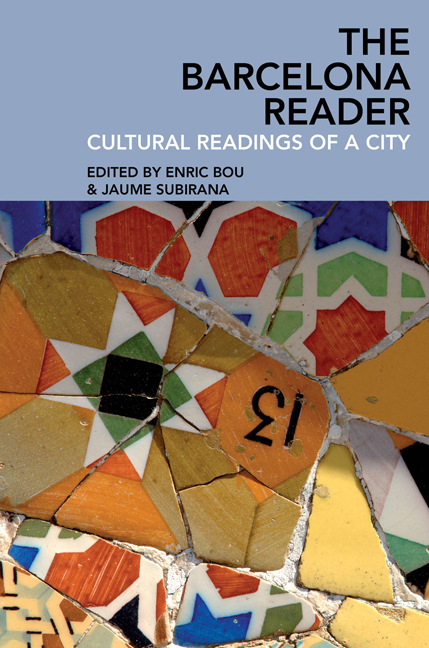Book contents
- Frontmatter
- Contents
- List of illustrations
- Notes on contributors
- Introduction: Barcelona: Cultural readings of a city
- I City, history, and territory
- II City and society
- III Art, architecture, and the city
- 10 Picasso among his fellows at 4 Gats: Beyond Modernisme?
- 11 Gaudí: Poet of stone, artistic hedgehog
- 12 El Poble Espanyol / El Pueblo Español (1929)
- IV The Olympics and the city
- V Literature, cinema, and the city
11 - Gaudí: Poet of stone, artistic hedgehog
from III - Art, architecture, and the city
- Frontmatter
- Contents
- List of illustrations
- Notes on contributors
- Introduction: Barcelona: Cultural readings of a city
- I City, history, and territory
- II City and society
- III Art, architecture, and the city
- 10 Picasso among his fellows at 4 Gats: Beyond Modernisme?
- 11 Gaudí: Poet of stone, artistic hedgehog
- 12 El Poble Espanyol / El Pueblo Español (1929)
- IV The Olympics and the city
- V Literature, cinema, and the city
Summary
New research has revealed a pioneering Gaudí who was well ahead of his time, the creator of innovative work processes in addition to the architectural forms that we all now know. The architect has left us a legacy that can be applied to a range of disciplines. The Diocesan Museum of Barcelona houses the book of condolence from the death of Gaudí. It is a considerable tome, documentary evidence of the architect's renown and the resonance of his presence. In it we find the names of political and cultural personages along with countless unidentified individuals. Of these individuals, who represent the majority – proof of how Gaudí was loved by the people – one name in particular caught my attention. It was nobody. What I mean is that this person was no authority, no one well known. Struck by the tragedy and aware of what the loss meant, this person expressed his grief and admiration on a sheet of paper. The text is beautifully written, measured in tone and rather long. The author must have given it careful consideration, because there are no second thoughts or erasures, and the text ends with a brilliant analogy: ‘If Verdaguer was the architect of literature, Gaudí was the poet of architecture’. Full of determination, the man must have gone to the chapel with his own paper, only to find that there was an official book of condolence. So he attached his text with pins, on the very page opposite the signatures of major figures in politics, art and society. The book is exhibited with this page open.
The magnitude and power of the collective grief expressed in writing is impressive. For the authors of the countless letters, telegrams and press articles, a saint, genius and patriot had died – the architect of God and the universe, the Dante of architecture. So clear, so resounding and so shared. But the fate of Gaudí quickly fell into a prolonged period of neglect and even contempt. Paradoxically, almost three-quarters of a century later, he would become one of the most original icons of Barcelona and in the history of art.
- Type
- Chapter
- Information
- The Barcelona ReaderCultural Readings of a City, pp. 265 - 294Publisher: Liverpool University PressPrint publication year: 2017



